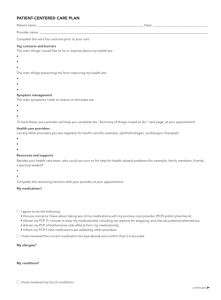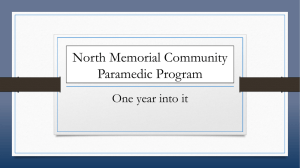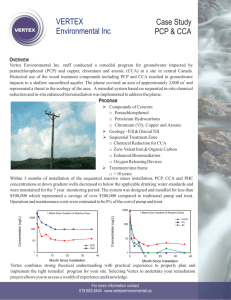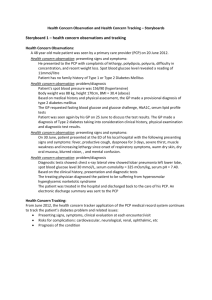Performance Co-Pilot Tutorials & Case Studies
advertisement
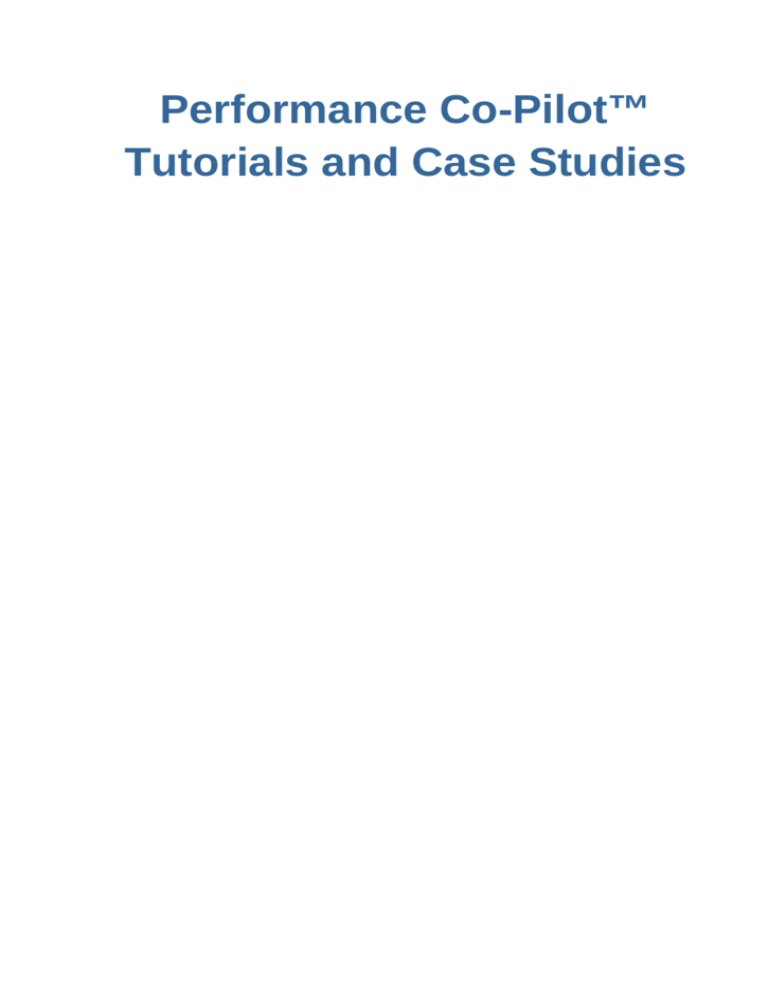
Performance Co-Pilot™
Tutorials and Case Studies
Performance Co-Pilot™ Tutorials and Case Studies
Performance Co-Pilot™ Tutorials and Case Studies
Maintained by:
The Performance Co-Pilot Development Team
pcp@oss.sgi.com
http://pcp.io
PERFORMANCE
CO-PILOT
Copyright © 2012, 2014 Red Hat, Inc.
Copyright © 2007, 2013 Aconex.
Copyright © 2000, 2013 Silicon Graphics, Inc.
LICENSE
Permission is granted to copy, distribute, and/or modify this document under the terms of the
Creative Commons Attribution-Share Alike, Version 3.0 or any later version published by the Creative
Commons Corp. A copy of the license is available at http://creativecommons.org/licenses/by-sa/3.0/us/
TRADEMARKS AND ATTRIBUTIONS
Red Hat and the Shadowman logo are trademarks of Red Hat, Inc., registered in the United States
and other countries.
Silicon Graphics, SGI and the SGI logo are registered trademarks and Performance Co-Pilot is a
trademark of Silicon Graphics, Inc.
Cisco is a registered trademark of Cisco Systems, Inc. Linux is a registered trademark of Linus
Torvalds, used with permission. UNIX is a registered trademark of The Open Group.
About This Book
v
1. What This Book Contains ................................................................................................. v
2. Audience for This Book .................................................................................................... v
3. Related Resources .......................................................................................................... v
4. Man Pages ...................................................................................................................... v
5. Web Site ........................................................................................................................ vi
6. Conventions .................................................................................................................... vi
7. Reader Comments ......................................................................................................... vii
1. Supported Platforms Installation
1.1. Linux Installation ...........................................................................................................
1.2. Mac OS X Installation ...................................................................................................
1.3. Solaris Installation .........................................................................................................
1.4. Windows Installation .....................................................................................................
1
1
1
1
1
2. Tutorials
2.1. Using PCP Charts ........................................................................................................
2.2. Logging Basics .............................................................................................................
2.3. Automated Reasoning ...................................................................................................
3
3
3
3
3. Case Studies
3.1. Understanding System-Level Processor Performance .....................................................
3.2. Understanding Measures of Disk Performance ...............................................................
3.3. An Operating System Upgrade Evaluation .....................................................................
3.4. Comparing Storage System Performance .......................................................................
3.5. Central Logging: Instrumenting Distributed Event Logs ....................................................
5
5
5
5
5
5
Index
7
iii
iv
About This Book
This book is a collection of tutorials, case studies, and short stories about various aspects of the
Performance Co-Pilot (PCP) performance analysis toolkit. Topics range from basic installation through
to detailed analysis techniques, with everything in-between, that even seasoned PCP users can
expect to learn from.
Much like PCP is an open source, cross-platform software package - where customizations are
actively encouraged - so too is this book. If you have interesting experiences to share, please consider
contibuting - the XML source to this book is available, along with the PCP source code.
“About This Book” includes short descriptions of the chapters in this book, directs you to additional
sources of information, and explains typographical conventions.
1. What This Book Contains
This book contains the following chapters:
• Chapter 1, Supported Platforms Installation, contains introductory topics around installation of PCP.
• Chapter 2, Tutorials, contains a series of hands-on tutorials covering use of specific PCP monitor
tools, secure collector setup.
• Chapter 3, Case Studies, provides a set of case studies of use of PCP to address problems, or
understand certain system behaviours using PCP.
It provides a series of real-world examples of using various PCP tools, and lessons learned from
deploying the toolkit in production environments. It serves to provide reinforcement of the general
concepts discussed in the other books described in the Section 3, “Related Resources”, with additional
case studies and more detailed discussion of individual tools.
2. Audience for This Book
This book has something for everyone - early topics will aid those getting started with PCP, while later
sections cover in-depth material, sometimes requiring detailed understanding of operating system
internals.
Some familiarity with the basic concepts behind PCP is assumed.
3. Related Resources
The Performance Co-Pilot User's and Administrator's Guide is intended for system administrators and
performance analysts who are directly using and administering PCP installations.
The Performance Co-Pilot Programmer's Guide is intended for developers who want to use the PCP
framework and services for exporting additional collections of performance metrics, or for delivering
new or customized applications to enhance performance management.
Additional resources include man pages and the project web site.
4. Man Pages
The operating system man pages provide concise reference information on the use of commands,
subroutines, and system resources. There is usually a man page for each PCP command or
subroutine. To see a list of all the PCP man pages, start from the following command:
v
About This Book
man PCPIntro
Each man page usually has a "SEE ALSO" section, linking to other, related entries.
To see a particular man page, supply its name to the man command, for example:
man pcp
The man pages are arranged in different sections separating commands, programming interfaces, and
so on. For a complete list of manual sections on a platform enter the command:
man man
When referring to man pages, this guide follows a standard convention: the section number in
parentheses follows the item. For example, pminfo(1) refers to the man page in section 1 for the
pminfo command.
5. Web Site
The following web site is accessible to everyone:
URL
Description
http://pcp.io
PCP is open source software released under the GNU General Public License (GPL) and GNU
Lesser General Public License (LGPL)
6. Conventions
The following conventions are used throughout this document:
Convention
Meaning
${PCP_VARIABLE}
A brace-enclosed all-capital-letters syntax indicates a variable that has been sourced from the
global /etc/pcp.conf file. These special variables indicate parameters that affect all PCP
commands, and are likely to be different between platforms.
command
This fixed-space font denotes literal items such as commands, files, routines, path names, signals,
messages, and programming language structures.
variable
Italic typeface denotes variable entries and words or concepts being defined.
user input
This bold, fixed-space font denotes literal items that the user enters in interactive sessions.
(Output is shown in nonbold, fixed-space font.)
[]
Brackets enclose optional portions of a command or directive line.
...
Ellipses indicate that a preceding element can be repeated.
vi
Reader Comments
ALL CAPS
All capital letters denote environment variables, operator names, directives, defined constants,
and macros in C programs.
()
Parentheses that follow function names surround function arguments or are empty if the function
has no arguments; parentheses that follow commands surround man page section numbers.
7. Reader Comments
If you have comments about the technical accuracy, content, or organization of this document, contact
the PCP maintainers using either the email address or the web site listed earlier.
We value your comments and will respond to them promptly.
vii
viii
Chapter 1.
Supported Platforms Installation
Binary packages for Linux (deb and rpm formats), Mac OS X, Solaris and Windows are made
available by the PCP development team.
These are all freely available from the download section of the PCP project web site.
1.1. Linux Installation
Pre-packaged binaries are available for the Linux platform ... XXX
1.2. Mac OS X Installation
After downloading the dmg file for your platform, double-click on the PCP dmg icon in the Finder
application, and follow the installation instructions presented by the Installer.
Mac OS X versions 10.5 and onward are generally available, although older versions can be built from
source.
1.3. Solaris Installation
Download and unzip the latest binary package from the PCP project web site.
To install the package for the first time, issue the following commands:
pkgadd -d pcp-${PCP_VERSION}
Say 'y' to all of the questions.
svcadm enable pmcd
To upgrade an existing installation, issue the following commands:
pkgadd -d pcp-${PCP_VERSION}
pkgadd -d pcp-${PCP_VERSION}
svcadm enable pmcd
1.4. Windows Installation
After downloading the PCP Glider msi file, right-click on the command prompt icon, select Run As
Administrator, and enter:
msiexec /i pcp-glider-${PCP_VERSION}.msi
cd C:\Glider\scripts
postinst.bat
The command line utilities can now be accessed from a Windows shell or the provided (POSIX) shell.
The graphical tools can be accessed via the Windows Start menu.
1
2
Chapter 2.
Tutorials
From a high-level PCP can be considered to contain two classes of software utility:
• PCP Collectors. These are the parts of PCP that collect and extract performance data from various
domains, such as the kernel or a database.
• PCP Monitors. These are the parts of PCP that display data collected from hosts (or archives) that
have the PCP Collector installed.
The tutorials of this section focus on various monitoring tools initially, and then finish up with some
extensions to collector systems not covered in the Performance Co-Pilot User's and Administrator's
Guide.
2.1. Using PCP Charts
...
2.2. Logging Basics
...
2.3. Automated Reasoning
...
3
4
Chapter 3.
Case Studies
3.1. Understanding System-Level Processor Performance
...
3.2. Understanding Measures of Disk Performance
...
3.3. An Operating System Upgrade Evaluation
...
3.4. Comparing Storage System Performance
...
3.5. Central Logging: Instrumenting Distributed Event Logs
...
5
6
Index
Linux Supported Platforms Installation
Max OS X Supported Platform Installations
Solaris Supported Platform Installations
Windows Supported Platforms Installation
7
8
